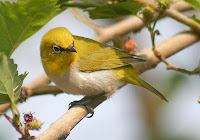Short URL for the story: http://goo.gl/TM2Ej
What is the connection between a Red-Whiskered Bulbul and Blueberries? According to a research correspondence published in the Current Science Journal, Red-Whiskered Bulbul, among other fruit eating birds, is instrumental in dispersing the seeds of the fruit bearing tree Syzygium cumini, often called as Indian Blueberry or Jambul.
What is the connection between a Red-Whiskered Bulbul and Blueberries? According to a research correspondence published in the Current Science Journal, Red-Whiskered Bulbul, among other fruit eating birds, is instrumental in dispersing the seeds of the fruit bearing tree Syzygium cumini, often called as Indian Blueberry or Jambul.
 |
Red-Whiskered
Bulbul (Pycnonotus jocosus)
|
Though the Red-Whiskered Bulbul spent lesser time than other
four fruit eating birds on each visit to the tree, it made significantly more
visits than other species, says the correspondence. By making standard
statistical measurements, the researchers have found that Red-Whiskered Bulbul consumes
significantly more number of fruits than the other fruit eating birds visiting the
tree.
Feeding behavior of birds on Indian Blueberry
 |
| Oriental White-Eye (Zosterops palpebrosus) Image Courtesy :Wiki Media Commons |
According o them, Red-Whiskered Bulbul and White-Cheeked Barbet swallows the Blueberry fruits while Blossom-Headed Parakeet eat only the pulp of the fruit by rolling it in the mouth before spitting the seed under the tree.
Similarly, Oriental White-Eye and Crimson-Backed Sunbird have a taste to peck up only the pulp of the fruit and leave the seed under the tree.
 |
| Crimson-backed Sunbird or Small Sunbird (Leptocoma minima) |
What makes Bulbul the best?
From the study it can be understood that there are many factors
which increase the importance of Red Whiskered bulbul as a major seed disperser
for Indian Blueberry.
- The fruiting season of the Blueberry coincides with the breeding period of the Red Whiskered Bulbul (the researchers observed that the bird often taking a fruit for the nestlings in the nest).
- The bird didn’t defecate or spit the seed under the mother tree like the other birds observed during the study. It gives more chances of the seeds to get deposited in other places.
- Red Whiskered bulbul nests were found on shrubs with Blueberry saplings around, which again shows that the saplings have more chances to grow up.
- Red Whiskered bulbul is a common bird in forest patches and cultivated land near forest fringes often undisturbed by human interference.
Other Seed Dispersing agents of Indian Blueberry
 | ||
| White-Cheeked Barbet (Megalaima viridis) |
The study was conducted by researchers at the Central University of Kerala
and ATREE in the Sopinabetta forests in Western Ghats situated at Sringeri
in Chikamagalur district of Karnataka during 2007 to 2008.

No comments:
Post a Comment
Please feel free to have your say on our stories. Comments will be moderated. anonymous Comments will not be approved. No links in the comment body unless meant for sharing a very relevant info.